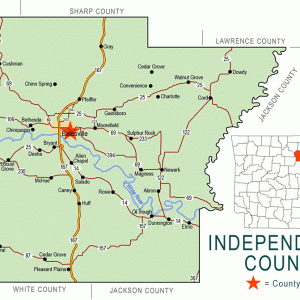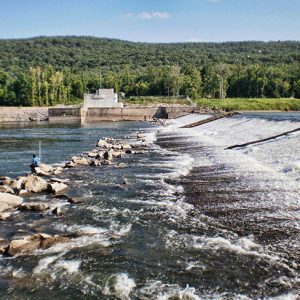calsfoundation@cals.org
Earnheart (Independence County)
Earnheart is a community on the north bank of the White River about three miles southeast of Bethesda (Independence County) and about four miles southwest of Limedale (Independence County). Across the White River from Earnheart is Earnheart Island near Lock and Dam No. 2. Created by the River and Harbors Act of March 1899, Lock and Dam No. 2 is presently own by Independence County; the old lock is being converted into a hydro-electric generating station. The Missouri Pacific Railroad runs through Earnheart.
The Mitchell family from Alabama was among the first to settle in the Earnheart area of Washington Township. Shortly after the Civil War, Charles Pierce Mitchell homesteaded 140 acres along Rock Branch (a.k.a. Rocky Branch), a stream that flows into the White River. The community of Earnheart began in 1887 as the site of Robert Washington (R. W.) Earnheart’s legal distillery. Earnheart was the youngest of six children. His father died in Rowan County, North Carolina, when Earnheart was one year old. His mother left with the children for Washington Township, where it is believed she had family. She died when Earnheart was ten, and he stayed with his older siblings. Following the death of his first wife, Martha Harmon, Earnheart married Mattie Winston from Greenbrier Township (Independence County) and moved to Batesville (Independence County). He and his family members opened a saloon on the corner of Main and Spring streets (Spring Street later became Central Avenue). Earnheart, a successful corn farmer in the White River bottoms, became a prominent and wealthy citizen of the county, owning much property, including the Earnheart Hotel in Batesville. His son, Sam Earnheart, was elected Independence County treasurer in the 1890s.
The distillery at Earnheart closed in about 1914. Copper pots from the distillery were later used by K&W Sorghum of Bethesda. R. W. Earnheart died in Bethesda in 1925 and is buried in Campground Cemetery there.
The community of Earnheart had a short-lived post office from 1914 to 1918 labeled “Earnhearts” by the U.S. Postal Service, with Mahala Young as postmaster. Before that, the post office at Graham (Independence County) served Earnheart.
R. W. Earnheart’s grandson, Finis Edward Earnheart, collected some 1,500 Native American objects in and around Batesville. He had some of them on display at his restaurant in the city, including a double-necked pot, arrowheads, a pottery effigy of a man on his knees, and other pottery. Earnheart’s was located on Main Street across from the Ben Franklin store and up the street from Ray’s Sandwich Shop in the 1950s.
Beginning in the early 1900s, the Chinquapin School served the Earnheart community. Chinquapin (Independence County) still maintained a school in 1936 but consolidated with Bethesda a few years later. Bethesda divided its district for consolidation purposes. On January 25, 1949, part of the Bethesda district was annexed to Cushman (Independence County) and the other part to Batesville. Bethesda kept an elementary school until the 1960s.
Charles Mitchell’s daughter Letona Mitchell of Chinquapin married Vernon Clifton Elms of Locust Grove, and the couple built a rustic log cabin across White River from Dean Mountain in the 1930s. The cabin became a popular place for musical performances. Musicians and songwriters Wayne Raney and Louie Clark of Wolf Bayou (Cleburne County) often visited to play music with Letona and Vernon’s son, Alan Elms. Elms later became a professor of psychology at the University of California, Davis. (Raney and Clark were unable to talk Elms into going on the road with them.) The cabin was gone by 1977, but remains are still visible.
The Earnheart Ferry was located on Rock Branch across from Earnheart Island. The Greenbrier (a.k.a. Greenbriar) Ferry was about three miles downstream on the White River. Farther up the river at Marcella (Stone County) was the Hess Ferry (a.k.a. Grigsby Ferry, later called O’Neal Ferry); it is technically still in use in the twenty-first century, as a Marcella farmer uses the old boat to haul hay and farm supplies across the White River. Fishing is popular on the Chinquapin Creek in the vicinity of Earnheart and at the Vaughn Wilson Lake Dam between Earnheart and Bethesda.
The first campus of the Arkansas Sheriffs’ Youth Ranches is located on Earnheart Road where the Earnheart distillery once stood. Founded in 1976 as Arkansas Sheriffs’ Boys Ranch, Inc., it is a charitable and educational organization that today provides residential and non-residential services to both boys and girls. A 528-acre site south of Bethesda on the White River was chosen for the ranch, and the first cottage was dedicated on October 10, 1977. The ranch occupies part of the land area of the old community of Earnheart.
Little is left of Earnheart today aside from the old slab where the distillery once stood. There is an Earnheart Lane at the site of the old post office, and Earnheart Road is the main highway from Rock Branch northwest to Bethesda where it intersects with Highway 106. As late as 1977, there was a sign at the Missouri Pacific railroad crossing reading “Earnheart.”
For additional information:
Biographical and Historical Memoirs of Northeast Arkansas. Chicago: Goodspeed Publishing Co., 1889.
McGinnis, A. C. “A History of Independence County, Ark.” Special issue. Independence County Chronicle 17 (April 1976).
———.“R. W. Earnheart and His Distillery.” Independence County Chronicle 16 (July 1975): 19–30.
Kenneth Rorie
Van Buren, Arkansas
 Independence County Map
Independence County Map  Lock and Dam Number 2
Lock and Dam Number 2 




Comments
No comments on this entry yet.